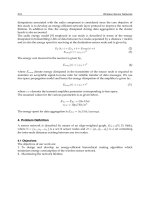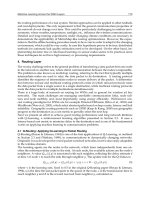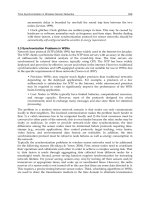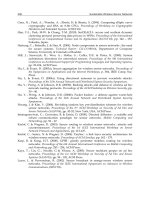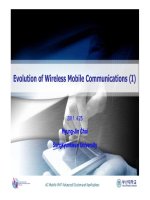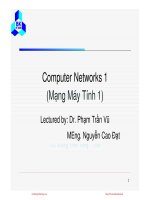Wireless networks - Lecture 10: Evolution of wireless networks (Part 3)
Bạn đang xem bản rút gọn của tài liệu. Xem và tải ngay bản đầy đủ của tài liệu tại đây (717.58 KB, 30 trang )
Wireless Networks
Lecture 10
Evolution of Wireless Networks (Part III)
Dr. Ghalib A. Shah
1
Review of previous lecture
Limitation of 3G
4G
►
►
►
►
►
►
Objectives
Issues
QoS
Security
Multimedia Service
Applications
Convergence of Cellular and WLAN
Billing Issue
Wireless Networks
Summary of today
2
Review of last lecture
2.5G
►
►
►
►
HSCSD
GPRS
EDGE
IS-95B
3G
► UMTS/W-CDMA
► CDMA2000
3
Specifications of 2.5G and 3G standards
Technology
Channel
BW
Duplex
Infrastructure Changes
New
Spectrum
New handsets
HSCSD
200 KHz
FDD
Software upgrade at BS
No
Yes, New headsets provide
57.6 kbps on HSCSD and
9.6 kbps on GSM
GPRS
200 KHz
FDD
New packet overlay at routers
and gateways
No
Yes, new GPRS sets work at
171.2 kbps, 9.6 kbps on
GSM, dualmode.
EDGE
200 KHz
FDD
New TX/Rx at BS, software
upgrade at BS, controller
No
Yes, new set work at 384
kbps on EDGE, GPRS at
144 kbps and GSM at 9.6
kbps, trimode
WCDMA
5 MHz
FDD
Completely new BS
Yes
Yes, new handsets work at 2
Mbps in WCDMA and rest
as above
IS95B
1.25 MHz
FDD
New software at BS
No
Yes, IS95B at 64kbps, IS
95A at 14.4 kbps and IS95
at 9.6 kbps
Cdma2000
1xRTT
1.25 MHz
FDD
New software at backbone, new
channel cards at BS, new packet
service node
No
1xRTT at 144 kbps and rest
as above. Older sets will
work.
Cdma2000
1xEV(DO/DV)
1.25 MHz
FDD
New software and cards upgrade
to 1xRTT
No
1xEV at 2.4 Mbps and as
above
Cdma2000
3xRTT
3.75 MHz
FDD
Backbone modifications and
channel cards at BS
May be
4 3xRTT at 2 Mbps and rest
as above
Limitatio ns o f 3G
Difficulty of CDMA to provide higher data rates
Need for continuously increasing data rate and
bandwidth to meet the multimedia requirements
Limitation of spectrum and it’s allocation
Inability to roam between different services
To provide a seamless transport end-to-end
mechanism
To introduce a better system with reduced cost
5
4G
Provide a comprehensive IP solution where
voice, data and streamed multimedia can be
given to users on an "Anytime, Anywhere"
basis, and at higher data rates than previous
generations.
No formal definition but certain objectives
► Fully IP-based integrated system
► Provides 100 Mbit/s and 1 Gbit/s speeds both
indoors and outdoors, with premium quality and high
security.
6
4G Objectives
A spectrally efficient system (in bits/s/Hz and bit/s/Hz/site).
A nominal data rate of 100 Mbit/s at higher relative speeds and 1
Gbit/s while client and station are in relatively fixed positions
High network capacity: more simultaneous users per cell
Smooth handoff across heterogeneous networks,
Seamless connectivity and global roaming across multiple
networks
High quality of service for next generation multimedia support (real
time audio, high speed data, HDTV video content, mobile TV, etc)
Interoperability with existing wireless standards
An all IP, packet switched network
7
Global information multimedia communication
village
8
Co nve rg e nc e o f Hig h S pe e d Inte rne t & Mo bility
a Majo r Drive r o f Future Wire le s s
The Wireless Industry has grown at enormous
pace over the past decade.
Over 2.5 billion subscribers to cellular services
are enjoying the benefits of staying connected
while on the move.
With the growth in Internet, a wide range of
services are accessed by users through a
wired infrastructure.
The introduction of mobile Internet brought
about by the convergence of Mobile & Internet
technologies is the future objective.
9
4G Concept
“The user has freedom and flexibility
to select any desired service with
reasonable QoS and affordable price,
anytime, anywhere.”
10
Design Objectives
11
He te ro g e ne o us Ne two rks
12
Ne xt Ge ne ratio n will als o have s pe c ific ally
ne e ds to re s o lve it’s o wn multiple is s ue s
He te ro g e ne o us ne two rks
Ac c e s s , hando ve r
Lo c atio n c o o rdinatio n, re s o urc e
c o o rdinatio n
Adding ne w us e rs
Qo S , wire le s s s e c urity and authe ntic atio n
Ne two rk failure bac kup
Pric ing and billing
13
14
Quality of Service (QoS)
Traffic generated by the different services will
not only increase traffic loads on the networks,
but will also require different quality of service
(QoS) requirements (e.g., cell loss rate, delay,
and jitter) for different streams (e.g., video,
voice, data).
Providing QoS guarantees in 4G networks is a
non-trivial issue where both QoS signalling
across different networks and service
differentiation between mobile flows will have to
be addressed.
15
Quality of Service
One of the most difficult problems that are to be
solved, when it comes to IP mobility, is how to
insure the constant QoS level during the
handover.
Depending on whether the new access router
is in the same or some other sub network, we
recognize the horizontal and vertical handover.
16
Hierarchical layer for 4G
17
Quality of Service
However, the mobile terminal can not receive IP
packets while the process of handover is finished. This
time is called the handover latency.
Handover latency has a great influence on the flow of
multimedia applications in real-time.
Mobile IPv6 have been proposed to reduce the
handover latency and the number of lost packets.
The field “Traffic Class” and “Flow Label” in IPv6
header enables the routers to secure the special QoS
for specific packet series with marked priority.
18
MULTIMEDIA – Vide o S e rvic e s
4G wireless systems are expected to deliver efficient
multimedia services at very high data rates.
Basically there are two types of video services: bursting
and streaming video services.
S tre aming : is performed when a user requires realtime video services, in which the server delivers data
continuously at a playback rate.
Burs ting : is basically file downloading using a buffer
and this is done at the highest data rate taking
advantage of the whole available bandwidth.
19
Security
Security in wireless networks mainly involves
authentication, confidentiality, integrity, and
authorization for the access of network connectivity and
QoS resources for the mobile nodes flow.
The heterogeneity of wireless networks complicates the
security issue.
Dynamic reconfigurable, adaptive, and lightweight
security mechanisms should be developed.
AAA (Authentication Authorization Auditing) protocols
provide a framework for such suffered especially for
control plane functions and installing security policies in
the mobile node such as encryption, decryption and
filtering.
20
Co nve rg e nc e o f Ce llular Mo bile
Ne two rks and WLANs
Be ne fits fo r
Ope rato rs
►
►
►
►
►
Higher bandwidths.
Lower cost of networks and equipment.
The use of licence-exempt spectrum.
Higher capacity and QoS enhancement.
Higher revenue.
Us e rs
► Access to broadband multimedia services with lower
cost and where mostly needed.
► Inter-network roaming.
21
Applications
Virtual Pre s e nc e : This means that 4G
provides user services at all times, even if the
user is off-site.
Virtual nav ig atio n: 4G provides users with
virtual navigation through which a user can
access a database of the streets, buildings etc.
Te le g e o p ro c e s s ing ap p lic atio ns : This is a
combination of GIS (Geographical Information
System) and GPS (Global Positioning System)
in which a user can get the location by
querying.
22
Applications
Te le Me d ic ine and Ed uc atio n: 4G will support
remote health monitoring of patients. For
people who are interested in life long
education, 4G provides a good opportunity.
Cris is m anag e m e nt: Natural disasters can
cause break down in communication systems.
In today’s world it might take days or 7 weeks
to restore the system. But in 4G it is expected
to restore such crisis issues in a few hours.
23
Multiple Ope rato rs and Billing S ys te m
In today’s communication market, an operator
usually charges customers with a simple billing
and accounting scheme.
A flat rate based on subscribed services, call
durations, and transferred data volume is
usually enough in many situations.
With the increase of service varieties in 4G
systems, more comprehensive billing and
accounting systems are needed.
24
Multiple operators and billing system
Different QoS
requirements
Different type
of services
4G billing
system
It is challenging to
formulate one single
billing method that
covers all the billing
schemes involved.
Multiple service
providers
25

